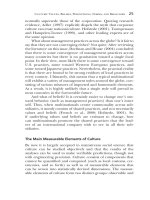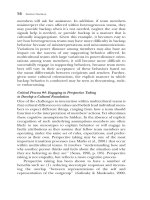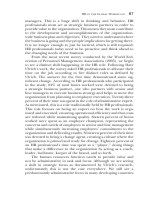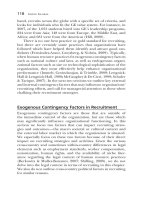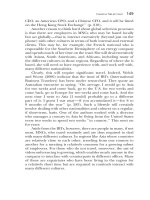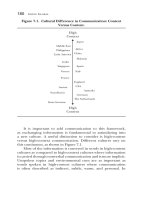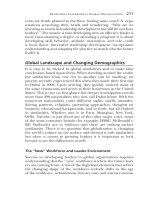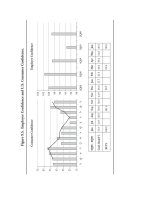Practical Applications and Recommendations for HR and OD Professionals in the Global Workplace_5 pptx
Bạn đang xem bản rút gọn của tài liệu. Xem và tải ngay bản đầy đủ của tài liệu tại đây (495.04 KB, 31 trang )
HR in the Global Workplace 87
managers. This is a huge shift in thinking and behavior. HR
professionals must act as strategic business partners in order to
provide value to the organization. This means they must contribute
to the development and accomplishments of the organization-
wide business plan and objectives. They need to understand where
the business is going and the people implications for getting there.
It is no longer enough to just be tactical, which is still required;
HR professionals today need to be proactive and think ahead to
the changing needs of the business.
From the most recent survey conducted by the World Fed-
eration of Personnel Management Associations (2005), we begin
to see a distinct shift happening in the HR role. Following Dave
Ulrich’s work, the survey asked HR professionals to allocate their
time on the job according to five distinct roles as defined by
Ulrich. The answers for the first time demonstrated some sig-
nificant change. According to HR professionals who participated
in the study, 24% of total hours worked were devoted to being
a strategic business partner, one who partners with senior and
line managers to execute business strategy and helps to move the
organization from planning to employee execution. Twenty-three
percent of their time was spent in the role of administrative expert.
As mentioned, this is a role traditionally held by HR professionals.
This role focuses on being an expert on how the work is orga-
nized and executed, ensuring operational efficiency and that costs
are reduced while maintaining quality. Sixteen percent of hours
worked were spent as an employee champion, representing the
concerns and needs of employees to senior and line management
while simultaneously increasing employees’ commitment to the
organization and delivering results. Nineteen percent of their time
was devoted to being a change agent, creating a culture where the
organization is primed and ready for change. Eighteen percent of
an HR professional’s time was spent as a ‘‘player,’’ doing things
that make a difference to the organization by acting as a coach,
leader, facilitator, keeper of the brand, and so forth.
The human resources function needs to provide value and
not be administrative in task and focus. Although we are seeing
a shift in strategic focus as documented by Ulrich’s research,
unfortunately this is not the case everywhere. We still see a
predominantly administrative focus in many developing countries
88 Going Global
(Yeung, 2005). The HR function needs to demonstrate that it is
a true strategic partner and shift away from the administrative
label it has carried for so long. Whereas this is still a challenge
in many developing parts of the world, strong HR functions
from progressive multinational organizations will provide tools
and resources and set powerful examples of what is expected
in a strategic HR professional. This is necessary to drive the
business strategy throughout the organization and the world. HR
professionals can be successful by focusing not on the HR activity
but on its intended business outcome.
Human Resources Design Framework
HR professionals need to demonstrate that they understand the
business and its needs at multiple levels. Successful HR profes-
sionals need to understand that there is no ‘‘one size fits all’’
approach for their human resources strategy. A successful man-
agement trainee program in Europe may not work as well in
Latin America without some local customization. How organiza-
tions implement their human resource strategy—locally versus
globally—has implications for organizational success.
Sometimes HR effectiveness lies in the details and not the big
picture. There are times when HR professionals must be tactical in
approach because it is up to them to manage such administrative
issues as monitoring compliance, ensuring managers are provid-
ing performance reviews, and ensuring that new employees are
registered on the payroll system. If these basics are not addressed
it becomes more difficult to resolve the larger strategic issues.
Being strategic versus tactical does not imply that one is more
important than the other; they are both important. Therefore,
understanding when to be strategic versus when to be tactical is
critical for an HR professional to demonstrate value.
Being successful tactically means having all the basics of
human resources in order. This includes a compensation and
benefits program, accurate employee records, policy develop-
ment and enforcement, hiring, and day-to-day employee relations
work. Though these basics are not necessarily what give an orga-
nization its competitive advantage, without them it would be
difficult to build a strategic platform (Christensen, 2006). The
HR in the Global Workplace 89
Figure 4.1. Human Resources Design Framework.
Tactical Strategic
Local
Global
Approach
Focus
Tactical/Global
Tactical/Local
Strategic/Global
Strategic/Local
strategic aspects of human resources are what can differentiate an
organization and provide its competitive advantage.
Figure 4.1 describes this two-by-two framework of focus and
approach or, more specifically, of global versus local and strategic
versus tactical. In the section that follows, we highlight examples of
business issues and how they can be addressed within this human
resources design framework. Each is important, and each cell of
the matrix provides value to the organization if it is addressing a
business need.
Strategic/Global
Global organizations with multiple locations are often faced with
business challenges that are global in scope and have a strategic
impact on the entire enterprise. A case in point is consolidating
operations for cost-saving purposes. For example, organizations
90 Going Global
with large call center operations have to strategically identify where
in the world it is most cost effective to operate a 24/7 call center
based on salary, benefits, and real estate, but also balance it with
a skilled, multilingual workforce ready to provide customers with
global 24/7 coverage. It is up to the human resources function to
perform the due diligence and identify the talent pool that can
staff such an operation on a cost-efficient basis. There are huge
implications for business operations which translate into customer
expectations and satisfaction. Customer satisfaction with the level
of call center service ties directly to bottom-line financial results.
Strategic/Local
Sometimes an HR professional must take a strategic approach to
a very local issue. The Middle East is an example of a growth
area with a traditionally expatriate-heavy workforce. As the Middle
East is transforming from a largely petro-based economy to more
of a service economy (financial services, tourism, and shopping
destination) there is a stronger need to convert the expatriate
workforce to a more local work force. This is a challenge because
the Middle East does not have the structures in place to feed
sufficient local talent into the talent pool (Hewitt Associates,
2009b). It becomes an even greater challenge when a country
like the United Arab Emirates (UAE) decides to limit visas and
make renewal of residence permits more difficult, thus inhibiting
expatriate recruitment. HR professionals need to take a very
tactical approach to a local problem.
In the UAE, almost 90% of the population is expatriate.
Many are low-wage workers from less-developed Asian or Middle
Eastern countries. They tend to be employed in construction and
domestic services such as hotels and restaurants. Expatriates from
India and Pakistan tend to be mid-level managers or technical
staff. Senior management personnel tend to come from Europe
(notably United Kingdom and Germany) and the United States
(Hewitt Associates, 2009b).
Retention is a huge issue in the Middle East as many expatriates
view their stay as a temporary, often developmental, career-
building assignment. They are waiting for their transition out.
If the organization does not ensure that the skill set stays then
HR in the Global Workplace 91
the local HR professional is scrambling to backfill, probably with
another expatriate. There is a huge need to build the talent locally
so as to reduce dependence on foreign workers. There may be a
need to retain some key expatriates until the skill set can be pro-
vided locally. This has obvious implications for pay and rewards.
Tactical/Global
Sometimes HR must take a tactical approach to a global issue.
For example, many organizations conduct employee engagement
surveys. Survey data help managers, and their respective organi-
zations, understand what drives employee engagement. Linkage
research has shown employee engagement to be related to cus-
tomer satisfaction and to financial results (Rucci, Kirn, & Quinn,
1998). Employee survey results have huge implications for how
managers run their operations.
Collecting employee data can be very tactical but crucial to
getting an accurate picture of employee issues. HR professionals
must work with line managers to ensure that every employee has an
opportunity during their workday to complete a survey whether
paper or Web-based. The employee must be able to read and
understand the survey in order to participate; therefore, surveys
must often be translated. For unskilled labor, language can be a
challenge. Even literacy in a native language can be a challenge.
The HR professional must ensure that the employee can partic-
ipate with a level of comfort. They must be able to participate
in a nonthreatening, confidential environment. Obviously, there
are many administrative details involved in running a successful
employee survey program. Tactical administration is important
because the data results not only have local impact but global
as well. Locally the data will be reviewed by management and
employees and a local action plan will be built. Globally the results
are important because they may influence global strategy. Linkage
research happens at the global level. Without a tactical approach
to data collection, there can be no global research.
Tactical/Local
There may be organizational issues which are local in focus and
require a very tactical approach to find a solution. Ensuring that
92 Going Global
thereisadequateofficeorworkspaceissuchanexample.As
organizations grow and hire additional staff, the original work
space may not be sufficient for the growing population. The HR
professional is often tasked with projecting staff growth and then
identifying and recommending alternative solutions. This can
include physically moving all staff to a new facility and location, or
moving some staff to a new location. This can also include identify-
ing and implementing innovative solutions such as telecommuting
programs, office hoteling programs, and office-sharing programs.
Identifying the appropriate solution is a very tactical approach to
address such a local issue of ensuring that every employee has his
or her own work space.
One can see how identifying the appropriate approach for
the specific focus can optimize organizational results. The HR
professional, in order to be successful, must be able to balance all
these views.
Managing Talent: Freedom within a Framework
As described earlier, organizations can reflect different stages
of globalization. By providing common frameworks in particu-
lar HR areas, the organization is creating a common language
and set of expectations. One size does not fit all, however, when
culture issues are brought into play. In order for these HR pro-
grams and processes to work, sometimes local customization is
in order. Organizations that can provide a common framework
while understanding and accepting that local customization may
actually enhance the HR offering have optimized ‘‘freedom within
a framework’’ for their local HR professionals. Creating the right
balance between global business and local market needs is the ulti-
mate contribution an HR leader can make (Hofmeister, 2005).
In the examples that follow we will describe some areas where
a common platform coupled with a flexible framework for local
implementation has proven successful.
Competency Models
Competency models, or success profiles, provide a common lan-
guage and framework for selection, development, and retention
HR in the Global Workplace 93
within an organization. Competency models are a set of job-
related competencies with identified behaviors that are related to
successful performance. Having a globally consistent, or common,
framework of competencies sets the performance expectations
throughout the organization. By identifying competencies for a
specific functional area—for example, sales—the organization
is stating that to perform successfully in sales these identified
competencies are critical. Validation studies provide supporting
empirical evidence. This common framework allows for consis-
tency in recruiting talent anywhere in the world. From a talent
management perspective, the common language and frame-
work allows for consistent development of employees and career
pathing and mobility. A successful pharmaceutical sales manager
in Florida should be just as successful in Lisbon when you look at
core capabilities. Of course other issues come into play when one
is discussing career mobility across countries. The successful sales
manager in Florida will not be successful in Lisbon unless she is
fluent in Portuguese and also sensitive to and in tune with the
Portuguese culture (as well as local regulatory policies).
HR also needs to be attuned to subtle differences in meaning
and semantics. The American definition of a competency may not
make sense in another country even though the construct may
be the same. For example, ‘‘Communicating Effectively’’ may be
defined in the United States as including the ability to speak up
and challenge one’s superiors. This is not a behavior that would
be demonstrated in Asian countries where the norm is to defer to
one’s superiors and not to challenge them.
Talent Management
Competency models act as the foundation for talent manage-
ment systems. Talent management systems include, but are not
limited to, performance appraisal systems, succession planning
processes, and 360-degree feedback systems. Global consistency
in talent management systems is desirable because it creates
a consistent framework and set of performance expectations.
‘‘Strategic thinking’’ in India should look like ‘‘strategic thinking’’
in Brazil; however, subtle differences in meaning and interpreta-
tions can and do exist. To the degree that performance behaviors
94 Going Global
can be made explicit, therefore, organizations can achieve com-
mon understanding. Further, ratings on tools like performance
reviews and 360-degree feedback can be culturally biased as well.
Some cultures are more direct and blunt in approach (European
cultures) and scores from these raters tend to be lower than their
Asian or Latin American counterparts who are more genteel or
less direct in their feedback.
Rewards and Recognition Systems
Rewards and recognition systems can be culturally bound. Though
organizations may have a global philosophy regarding reward sys-
tems, the reality is that reward systems will be most effective if they
satisfy the employees’ needs. In the United States, health care ben-
efits are an important part of a total rewards system. Employees
may actually be attracted to and get recruited by an organization
because of its generous benefits package. In other countries where
health care is not provided by employers but by the government,
other benefits are considered important. One needs to be aware
of potential differences in contextual meaning. There is often
confusion to the typical survey question ‘‘my company provides
me with the benefits my family and I need.’’ In the United States,
‘‘benefits’’ is generally understood to be health care benefits. In
many countries, there is socialized medicine so the organization
is not providing health care coverage. Employees in these coun-
tries interpret benefits to mean other benefits such as discounts
with business partners or suppliers. Sometimes ‘‘benefits’’ is not
understood at all. Therefore the organization would not be able
to use a global rollup of data to make any organizational decisions.
In this situation local data, interpretations, and customs are much
more meaningful.
When designing global reward programs it is important to
remember that what is valued is also different across the world
and culturally driven. Cash may be king in certain countries over
material goods or awards. When a large global organization, at
which one author was employed, tried to design and implement
a global recognition program, it was obvious that one design
program would not work. HR professionals from the United States
wanted to create a program that would be special and pamper the
HR in the Global Workplace 95
employee so that it would be a memorable award. If the employee
was chosen ‘‘employee of the month’’ he or she would win a
beautiful award with his or her name engraved on it, and would
also be able to choose from a catalog of merchandise. The thought
was that employees would be able to have something that they
would not normally purchase for themselves, such as a beautiful
Tiffany necklace. To give cash as an award was seen as tacky. The
HR professionals from outside the United States, though, had a
totally different perspective. For many employees in the Middle
East or Asia, cash is king. Though the award would be appreciated,
many front-line employees had left their family in their home
country to live elsewhere and earn a living to support their families
back home. A statuette with their name on it and a Tiffany necklace
might be beautiful, but their immediate need and concern was to
earn money to help their family. A catalog of merchandise would
not be well received. In fact, it would be seen as frivolous and
actually might reduce the perceived value of the recognition.
Technology
Technology plays a huge role in uniting an organization and its
common mission. IBM leverages the same intranet and database
of resources whether the employee works in New York, Germany,
or Japan. Technology can enable global conversations and the
sharing of important work or client information almost instantly.
A common technology platform provides consistent input and
output of data. It allows for rollup of information at a local,
regional, country, and global level. The common technology
unites the organization in its mission and development goals
for its employees. Although most technology platforms operate
in the organization’s official language (often English), customiz-
ing the technology so that local languages can be used may allow
for greater participant utility. For example, creating common
intranet pages that can be translated locally allows for greater
information sharing.
A successful global HR function leverages technology. Tech-
nology becomes the enabler that allows HR to streamline talent
management, workforce management planning, and workforce
analytics. It can address many of the administrative tasks for HR
96 Going Global
in order to allow HR professionals to focus their energies on the
more strategic aspects of their work.
Employment Law
As seen with compensation and reward, not all aspects of human
resources programs and policies can be applied globally, because
employment laws are specific to each country. Laws, work councils,
and unions can govern who is hired, how work is performed, and
how employees terminate. The differences between the specific
social welfare programs should be interpreted as an opportunity to
share best practices, identifying which kind of employment condi-
tions could be culturally adopted across geographical boundaries.
Particularly within the European labor market, the number of
legal dispositions that are commonly used within the European
Union (EU) are progressively increasing and allow the opportu-
nity to adopt general programs such as health care, integrative
pension plans, job-on-call, job sharing, work from home, and
part-time work for experienced employees who are not ready for
permanent retirement. Across European companies, the interde-
pendent role of the European Works Council, which is focused on
sharing information and best practices, rather than on negotiating
with local trade unions, provides a common framework to link
local economics, business objectives, employment conditions, and
training programs.
HR Metrics
As mentioned throughout this chapter, creating commonalities
across the organization produces common and consistent lan-
guage and business goals. HR metrics can play an important role
in creating this common language. Both authors were involved in
the development of a global engagement survey. The dimensions
and items reflected common issues across the organization that
needed attention and monitoring. The survey dimensions com-
municated to managers globally that these were issues in which
the organization was interested and intended to hold managers
accountable for. Regression analysis indicated common themes
HR in the Global Workplace 97
across the different geographical divisions. Feedback and action
planning had the most impact at the local level. Here is a situation
where local is more powerful than global. Although the organi-
zation identified some consistent themes and global issues, data
analysis, feedback, and action planning are much more effective
at the local manager level.
Other key HR metrics that organizations may capture and
analyze at a national level can be action planned at a local
level. One could argue they have more effect at a local level.
Application rates, turnover rates, and so on reflect the local
employment conditions and local organization more than they do
the entire enterprise. If the data trends are consistent across the
organization, then there are truly enterprise-wide issues to look at.
Staffing: The Off-Shoring Experience
Off-shoring is a challenge to the HR function because off-shoring
presents a shift in how HR professionals have traditionally oper-
ated. Instead of moving the talent to where the work is, off-shoring
is moving the work to where the talent is.
The trend toward off-shoring of work started in the early part
of this century as organizations identified rich talent and cheaper
operating expenses in India. Organizations with large call center
operations, such as airlines and information technology (IT)
service companies, have tended to gravitate toward this trend.
IBM and Accenture have led the way with major operations in
India. Some organizations have more staff off-shore than they
do in their domestic locations. There has been such angst and
backlash around off-shoring, however, that most organizations will
not even publicize employee populations by country because they
do not want to be accused of off-shoring.
Shifting to Right-Shoring
By the end of this decade we will have seen the shift from
off-shoring to right-shoring. As off-shoring has leveled out, com-
panies are now searching for the right answer, rather than the
least expensive solution. Right-shoring is the restructuring of an
organization’s workforce to find the perfect mix of jobs that can
98 Going Global
be moved to foreign countries or be performed locally. In right-
shoring, a company outsources its simpler and not-so-important
processes to other countries, while retaining the complex pro-
cesses in-house. Organizations feel that by handling the complex
and important requirements of their business they can benefit
from improved customer relationships and have a better control
over their business. Right-shoring is all about maintaining a bal-
ance about the work that can be sent overseas and the work that
canbestbedonewithintheorganization.
The HR professional plays a huge role in whether or not right-
shoring is a success for the organization. The HR professional must
understand the work that needs to be done, the skills necessary
to be successful, and then identify where those skills exist in
abundance. Once the region, or location, is identified, then the
critical task of selection begins.
Human Resources Program Implementation
In a global organization it is na
¨
ıve to believe that whatever is
created in headquarters, a center of excellence, or one of the
divisions will be flawlessly implemented throughout the organiza-
tion. With globalization comes complexity in program design and
implementation. We cannot assume that the common platforms
described in the previous section will result in local success without
some specific attention. For flawless implementation, we outline
some recommended steps in this section.
Role of Human Resources Professionals
The human resources function and its professionals play a critical
role in ensuring that the organization’s business strategy is exe-
cuted and successful. As mentioned earlier in this chapter, human
resources is the best positioned to help an organization succeed
and bring its business strategy to life globally. By harnessing the
strengths and talents of its employees, organizations can create
competitive advantage.
HR professionals must be able to understand the tools and
processes developed to operate the business. Only by their knowl-
edge can they communicate and educate constituents on the
HR in the Global Workplace 99
value and use of the tools. Performance management is an
obvious example. The value of a performance management pro-
cess is not in completing the forms but in setting the goals and
having the performance discussion. Is the employee on track
to achieve the goals? This is important because goal achieve-
ment should be directly tied to organizational performance and
success. Too often HR professionals are in the policing role,
checking for compliance if the goal and appraisal forms are
complete rather than taking the time to educate their managers
and employees on the value of the tool to operate the business.
They also tend to focus on the quantity of reviews completed
versus the quality of the reviews and discussions. This occurs
because the HR professionals themselves do not truly understand
the value. In order for HR to be advocates and to champion
the tools and processes, they themselves need to be educated.
Too often organizations implement HR systems without ensur-
ing that the users or advocates actually understand them. Again
the focus is on the HR activity instead of the intended business
outcome. Further, human resources specialists, such as compen-
sation and benefits professionals, talent management, learning
and development, and selection and staffing professionals, must
work closely with their generalist partners and line management
to support the business strategy and goals. Once the business
needs and related human capital needs are identified, the spe-
cialist and generalist partnership often produces a very effective
solution.
Global Task Force
Creating a global task force of HR professionals representing dif-
ferent geographies (for example, North America, Latin America,
Europe, Africa/Middle East, and Asia Pacific) will allow for diver-
sity of thought and input into the program design. Even within
geographical areas there will be differences in culture that need
to be accommodated for (for example, China is not like Australia
even though they might be managed the same way, by the same
management team, in Asia Pacific). Having global representation
will make the program design and implementation run more
smoothly because the representatives will have had a voice from
100 Going Global
the beginning. Task force members will be able to provide invalu-
able insight to the design. They can field test the idea in local
markets to ensure clarity of message and intent to minimize any
confusion before launch. They will be able to identify the nuances
that might impact the program locally. They will also be able to
identify issues or barriers and be able to offer solutions for flawless
implementation. Task force members are now key stakeholders
who have a vested interest in the success of the program or initia-
tive. They will be able to galvanize their local management team’s
support to ensure program success.
Pilot and Phased Approach to Implementation
It is recommended to start small with any initiative and create
a pilot and then a phased approach to implementation. Choose a
subpopulation of the larger population but pilot it globally. For
example, one of the authors was responsible for the design and
global rollout of a 360-degree feedback program. The first year
was considered a pilot and only general managers were invited
to participate (around 900 employees globally). The following
cycle was expanded to include general managers and their direct
reports. It also included headquarters managers. By the third
cycle, department heads were invited to participate. In a three-
year period the 360-feedback participant population went from
900 to 8,000. In every cycle issues were identified and resolved
before the next implementation.
Ensure Functional Buy-In
Human Resources professionals must believe in the value of
the tools and processes. They are often participants as well as
implementers. If they do not understand the value then it becomes
a compliance task for them and for their employees. In order for
HR processes to have true business impact, they must be optimized
and considered part of business operations and not ‘‘another HR
program.’’ The task force approach, as mentioned earlier, can play
a role in creating functional buy-in. The task force representatives,
as part of their role, need to communicate to their local HR teams
not only what the program or initiative is about but also the
business outcome it addresses and the value of the approach.
HR in the Global Workplace 101
Ensuring functional buy-in is critical because HR professionals are
tasked with ensuring that employees and managers understand
the intended outcome of the initiative.
Create Local Champions
In order for HR professionals to be the ‘‘arms and legs’’ of imple-
mentation, they need to be champions of the process. Creating
local champions provides the organization and its employees with
local knowledge experts who can ensure program optimization
and success.
Local champions can include task force representatives but
they should include others notonthetask force as well.Champions
can be HR or line professionals; this is a great development
opportunity for both. They can develop depth of expertise whether
it is in selection, talent management, organization development,
or another HR area. Depending upon the initiative, the local HR
leadership may determine that it makes better sense for local
line management or employees to be the champions. In the
case of an employee engagement survey, where anonymity and
confidentiality are always questioned, a better solution would be
to have local employees, and not HR, as champions.
Local champions will be able to identify the best way to imple-
ment and utilize the intended initiative. For example, a local
champion in Turkey may determine that supervisors in their loca-
tion should not participate in their local 360-feedback initiative
because, although they have a ‘‘supervisor’’ title, locally their
responsibilities do not include actual performance management
or direct supervising responsibilities. A headquarters mandate that
all supervisors participate in 360-feedback should be addressed by
the local champion with an explanation of why it would not make
practical sense to participate.
Challenges to Implementation
The recommendations listed above are meant to provide guidance
around implementation. However, there are a number of issues
to consider when implementing a new HR initiative or even
making changes to an existing program or process. Customizing
or tailoring these to fit local needs will enhance success.
102 Going Global
Changing Demographics
The complexity of managing demographics (for example in Ger-
many, where hiring skilled immigrants is more complicated and
the age range is more skewed than in countries such as the United
Kingdom), combined with the pressure on productivity results
and profitability margins, are forcing an increasing number of
European companies to launch innovative solutions to increase
their intellectual capital.
Managing demographics is fast becoming one of the most
pressing issues for HR professionals. They must manage skill
and productivity loss resulting from turnover of young talent
and the retirement of an aging workforce. This is especially true
in the United States, Canada, Australia, and much of Europe.
Both challenges pose several threats, among them: the increase in
absenteeism, health care, and pension plan costs; the potential loss
of knowledge as experienced employees leave the company; and
the difficulty of motivating older workers. With the war for talent
there is concern that there will be fewer qualified employees
entering the labor market. Organizations need to identify new
staffing solutions based on modeling labor demand by job family
in addition to the traditional venues of succession planning,
restructuring work, and early retirement.
Though in the United States we have long heard of the war
for talent and concern for talent shortages when baby boomers
retire, global demographics tell us that the baby boom has not
yet occurred in many developing countries. Whereas the United
States is concerned that baby-boomer retirement will result in a
skill gap, the working age population in developing countries is
still relatively young. Populations may be decreasing in Europe
but they are increasing in India. That is good news, especially in
our emerging economies.
Languages
In a global organization, translations become a standard operating
practice. This is not just for HR initiatives but for any business
initiative that must be communicated.
For communication to be clear and accurate, it is important
that the meaning is translated—not just the words. There are
subtle nuances of language that get lost in the literal translation.
HR in the Global Workplace 103
The challenge is that often you are not just dealing with the local
language but the local dialect. For a lower-skilled, less-educated
employee population, ensuring that the level and meaning are
captured is a challenge.
One way to address this issue is to have in-country employees as
reviewers to translate and retranslate, or validate, the message con-
tent. The original translation can be completed by a translation
service (these services tend to employ local country nationals).
The translation should be followed with a back-translation by
an in-country employee to ensure that it matches to the orig-
inal meaning. The original translation can also be completed
by an in-country employee, however the back translation is key
and should be performed by a different in-country employee.
Nuances in languages are usually seen here. It is possible to say
something multiple ways—all of which may be correct. The deci-
sion then is which translation to accept. Sometimes it is best to
accept the employee translation over the translation service as it
assumes employee buy-in to the process and the creation of an
invested employee stakeholder. Translation and retranslation take
a great deal of time. Expect some back and forth as translations are
validated. This does take time and should be explicitly planned
for in any project plan.
It is critical that messages are not ‘‘lost in translation’’ and
that the intended message or purpose of the initiative is what
is communicated in the end. One of the authors was involved
in a situation where a translated performance evaluation form
implied that the goals and objectives were optional and not
necessarily formal or enforceable (oh, the subtleties of language).
In this European country it was actually easier to operate this
way because if goals were optional you did not need to get buy-
in or approval from the unions or work councils. However, it
was critical to the performance and success of the organization
that employees understood their job and its required goals and
associated objectives.
Legal Issues
As programs are designed, it is always easy to assume that they will
work everywhere. Even with thoughtful due diligence and global
representation, sometimes country-specific regulations or legal
104 Going Global
issues may stand in the way. Assumptions tend to get challenged
in a global environment. A case in point—one of the authors was
responsible for creating a global employee relief fund. The fund
would be used for employees in economic need after a disaster
(natural or otherwise) resulting in a loss or hardship. In a global
organization, a tsunami in Asia not only affects local employees
but it also provokes compassion from fellow employees all around
the world. The goal of the program was to raise funds through
donations from employees, with a match from the organization.
It would seem easy enough in concept, however, not so easy in
implementation. It was discovered during the implementation
phase that some countries do not allow money to actually leave
their country, thereby making donations impossible to collect.
China could solicit donations and raise money from employees,
but the money could not leave the country and be part of the
‘‘global’’ account. The money had to stay in China and could be
used only for Chinese employees in need. Technically this was
in conflict with the mission of the program where the goal was
a global fund to which all employees could contribute and also
apply for a relief fund grant. In addition, though donations to
charities are considered tax deductible in most countries, this is
not universally the case. Local tax laws had to be identified and
communicated with the rollout of the program. which created an
added level of complexity.
Ethics and Compliance Issues
The economic turbulence of 2008 and 2009 has shed new light
on ethics and compliance issues. Whereas almost all multina-
tional organizations have ethics and compliance programs (as
mandated by their local country’s laws), cultural issues affect how
they actually operate. In order to develop and implement global
ethics programs and hotlines, organizations need to address some
challenges, including how to communicate a consistent business
ethics policy in manylanguages. If organizations are implementing
a global hotline, the hotline services must be localized to conform
to local language and cultural norms. Another development in
recent years is that organizations now have to address interna-
tional data privacy laws, including whistleblower guidelines and
HR in the Global Workplace 105
data transfers (EthicsPoint, 2009). Data privacy laws have made
general business as well as HR-specific operations more challeng-
ing. Outside the United States, multinational organizations must
tend to the often conflicting requirements of local governments.
France, Belgium, Spain, Canada, Germany, Ireland, and Japan
are just some of the countries with differing data privacy laws that
must be addressed. Global organizations must be aware that many
cultures are extremely wary and some are averse to the practice
of whistleblowing. In addition, what is considered unethical or
illegal behavior can vary widely, further complicating attempts to
adopt a uniform ethics program. The data protection require-
ment and language barrier in many multinationals can make
it very difficult to capture information about, and investigate,
possible misconduct.
Future of Global HR Management
With the economic events of 2008 and 2009 behind us, we wonder
about the future and the implications for global HR management.
Shifting Role of Human Resources
The human resources business partner model,asdescribedearlier,
has to adapt to meet the changing business challenges which will
continue to evolve, for the immediate time being, with uncertainty.
However, all this uncertainty can be to an HR professional’s
advantage. HR can define the future based on predictable trends
(such as demographics or business growth) but it can also step
up to the challenge of defining its own future. HR has evolved
over the last several decades as businesses have evolved. The
administrative and transactional roles of the past have given way
to a strategic business partner model. Some are advocating that
the next evolution of the role will take us to an internal consultant
model (Vosburgh, 2007) where HR is not pushing an HR agenda
but instead helping clients in their respective businesses to solve
difficult business problems.
Globally, the HR function is in different places in its evolu-
tion. In many of the Asian countries we still see remnants of a
transaction-based HR function as they are still technically in the
106 Going Global
first generation of a free enterprise system. Multinational orga-
nizations need to ensure that their global HR professionals have
the skill sets to support their organizational clients for the future.
Creating world-class HR talent globally should be a top priority of
every chief human resources officer.
Emerging Economies
As global markets expand, what are the implications for
human resources? Will there be special focus on the BRIC
economies—Brazil, Russia, India, and China? For the last several
years these countries have been identified as emerging economic
powerhouses and, for many multinational organizations, these
countries have been a focus for economic growth. It is predicted
that by 2035, the combined gross domestic product (GDP) of
these four countries will become bigger than the G7 (Kowitt,
2009). This has huge human resource implications as HR
professionals will have to select, develop, and retain employees
in these emerging economies for years to come. They will have
to balance expatriate staffing, which will be necessary for the
exploding growth, with cultivating and nurturing local talent
development.
Our growing global service economy continues to put the
spotlight on talent. Talent acquisition, retention, and develop-
mentareevenmorecriticalinaserviceeconomythanina
traditional manufacturing economy.
Identified Needs
A survey of over 4,700 executives by the Boston Consulting Group
(2008) found that managing talent and improving leadership
development were consistently top concerns globally. In North
America, survey participants perceived the critical challenges to be
managing talent and demographics, improving leadership devel-
opment, managing work-life balance, and transforming HR into
a strategic business partner. In Latin America, the top two future
HR challenges identified were managing work-life balance and
managing talent. In Europe, managing talent and demograph-
ics emerged as key challenges. In Africa, executives identified
HR in the Global Workplace 107
managing talent, work-life balance, globalization, and diversity
as major future challenges. The key HR challenges in Emerg-
ing Asia (China and India) were identified as managing talent,
improving leadership development, becoming a learning organi-
zation, and managing work-life balance. Executives in Established
Asia (Singapore, Japan, South Korea) were primarily concerned
with managing globalization, talent, and improving leadership
development. In the Pacific Region, executives named managing
talent, improving leadership development, managing demograph-
ics, managing change, and cultural transformation as critical HR
challenges. We are beginning to see some shift in priorities as
now managing the work-life balance of employees seems to be
gaining importance, especially in countries where work councils,
or unions, play a huge role in the labor market.
Deglobalization
Given recent world events one might even argue that we are
seeing a shift to a deglobalization or relocalization. Sustainability
is not only a media topic and popular cause, but it has also
become embedded in most organizational strategies. Individuals
and organizations are noting and using local resources versus
a global supply chain, as evidenced by trends such as the slow
food movement. This has implications for talent resources as well.
Though it is still too early to conclude whether the pendulum has
swung in the other direction, if we do begin to see an increased
emphasis on localization, then we will probably also begin to see a
decrease in talent mobility with increased emphasis on identifying
and growing local talent.
Human Resources as a Decision Science
For human resources to continue to evolve, we need to maintain
focus on human capital as the differentiator of organizational
success. A key correlate is the ability to measure success. The
successful HR function of the future will have the ability to
measure key metrics and become more of a ‘‘decision science’’
(Boudreau & Ramstad, 2007) thereby measuring its impact on
business outcomes rather than HR activities. The focus needs to
108 Going Global
shift from the services that HR provides to the business decisions
that HR informs and supports.
Human Resources professionals will also become more aware
of capital markets and the role that intangible assets such as
human capital play in sustaining those markets. The investor
community is now interested in such HR practices as succession
planning, leadership development, corporate culture, and execu-
tive compensation as data points in buy-or-sell decisions (Ulrich
& Brockbank, 2009).
In conclusion, if HR is successful in harnessing the strengths
and talents of its employees, it stands to reason that the enterprise
will be successful. Understanding our global complexity, the value
of human capital, and the value that the human resources function
can provide to meet the business challenges can create an exciting
future. Organizations are not productive or profitable if they do
not have the right talent in the right roles aligned with the business
strategy. Human resources professionals are the best positioned
to create this alignment and help an organization succeed by
bringing its business strategy to life globally.
References
Boston Consulting Group (2008). Creating people advantage: How to address
HR challenges worldwide through 2015.
Boudreau, J., & Ramstad, P. (2007). Beyond HR: The new science of human
capital. Boston: Harvard Business School Publishing.
Christensen, R. (2006). Roadmap to strategic HR. New York: American
Management Association.
Corporate Leadership Council (2009). Building HR business partner
capabilities in continental Europe.
EthicsPoint (2009). www.ethicspoint.com.
Hewitt Associates (2009a). Managing HR on a global scale: Findings
from Hewitt’s 2009 Global HR Study.
Hewitt Associates (2009b). Foot on the gas: Managing human resources
in the Middle East.
Hofmeister, J. (2005). Global and local balance in human resources
leadership. In Losey, M., Meisinger, S., & Ulrich D. (eds.), The
future of human resource management. Hoboken, NJ: Wiley.
Kowitt, B. (2009). For Mr. BRIC, nations meeting a milestone. CNN-
Money.com, June 17, 2009.
HR in the Global Workplace 109
Rucci, A. J., Kirn, S. P., & Quinn, R. T. (1998). The Employee-customer-
profit chain at Sears. Harvard Business Review, 76, 1, 95–112.
Ulrich, D. (1997). Human resources champions.Boston:HarvardBusiness
School Press.
Ulrich, D., & Brockbank, W. (2009). The HR business partner model:
Past learnings and future challenges. People and Strategy, 32,2,5–7.
Vosburgh, R. M. (2007). The evolution of HR: Developing HR as an
internal consulting organization. Human Resource Planning, 30,3,
11–23.
World Federation of Personnel Management Associations. (2005). Survey
of global HR challenges: Yesterday, today and tomorrow.
Yeung, A. (2005). Becoming business partners in Chinese firms: Chal-
lenges and opportunities. In M. Losey, S. Meisinger & D. Ulrich
(Eds.), The future of human resource management. Hoboken, NJ: Wiley.
PART 2
Attracting
and Selecting
Employees in the
Global Workplace


